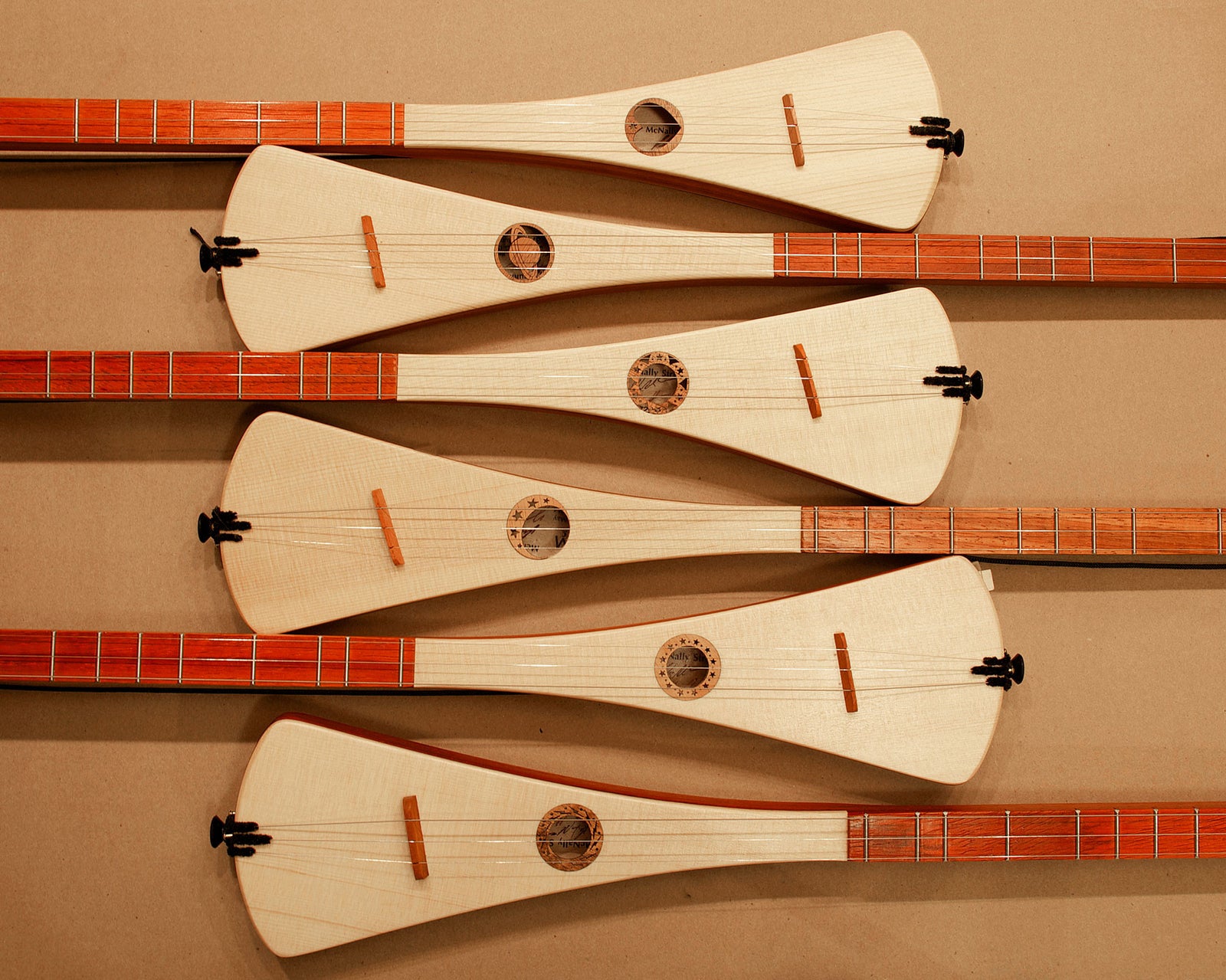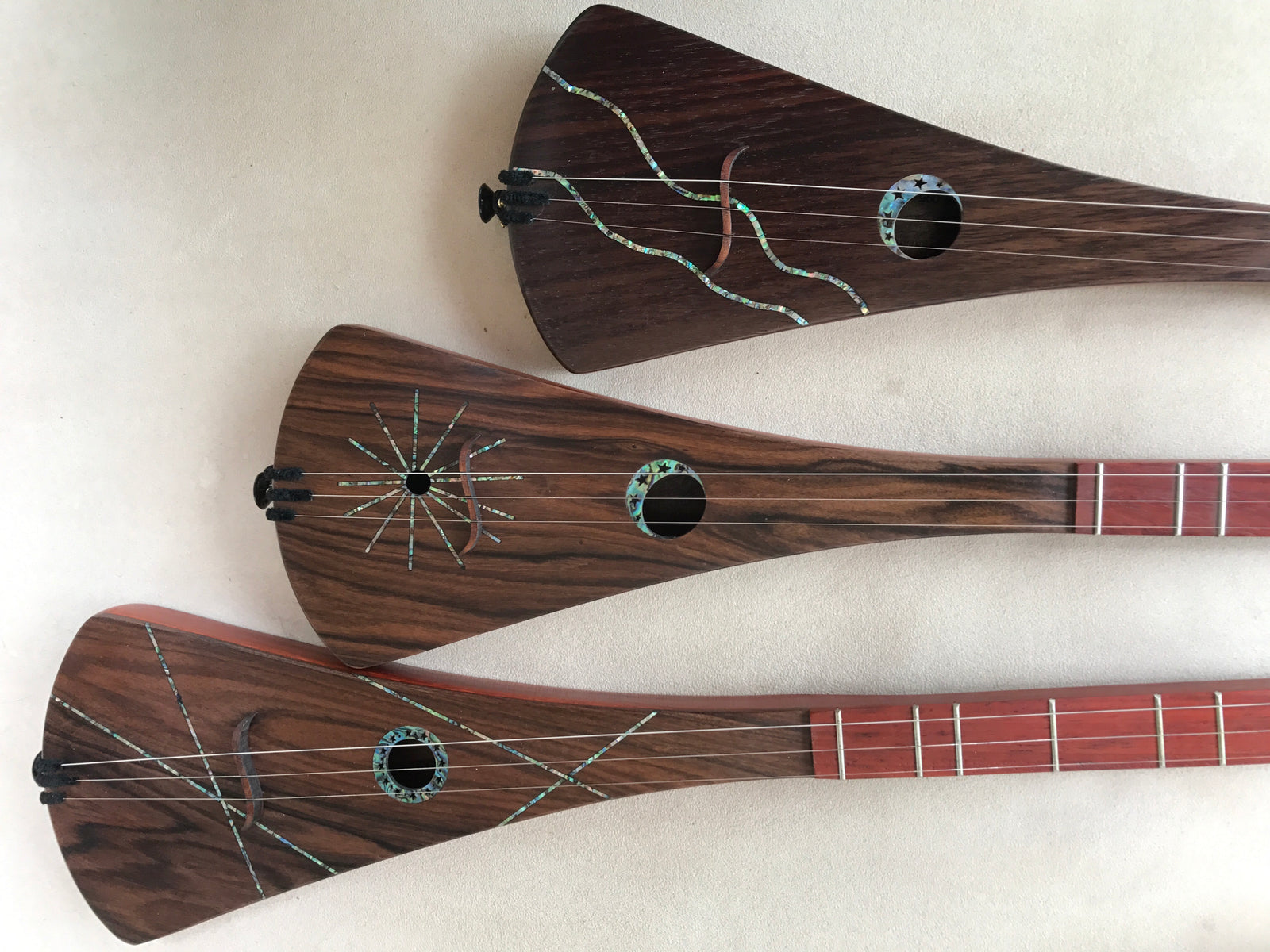K. Smith recently wrote to us about the Heart-shaped soundhole on our Valentine's day special, asking if it sounded different compared to a round soundhole. A very good observant question. Answering her question prompted me to write this article. If you ask people what the soundhole is for on a guitar (or a Strumstick), most people will say, "to let the sound out". For fun, I looked up that question on the web and was delighted by the range of mostly incorrect answers, ranging from "let the sound out" to "letting the vibrations from the strings fall into the body" to "spreading the soundwaves" and "it acts like a speaker". The interesting thing is that all those answers, while technically incorrect, dance around what people's experience suggests to them. You could say they are poetic answers.
The strings vibrate, and their vibration is transferred to the top (soundboard). The top vibrates up and down, in a variety of "shimmying" patterns too small to see. The top vibrating moves the air around it, which carries sound energy to your ears. The strings themselves have very little surface area, and barely disturb the air around them; the top has a large area and displaces much more air as it vibrates. An interesting trade-off is that the strings would vibrate much longer if they were connected to rigid structures at each end, instead of a flexible soundboard. The energy of the strings is quickly damped out by the work done to vibrate the top, and the top is slowed down by all the air it disturbs. So strings, top, and air are a coupled system, affecting how each other vibrate. And the sound is being made by the outside of the top, it doesn't need to be "let out" at all.
So what is the function of the soundhole? For one thing, it lets the air inside the soundbox move out and back in again as the top "pumps" up and down. If there were no openings, the air in the soundbox would be stretched and compressed like a spring, and dampen out the vibration of the top even faster. Letting the air inside the box squirt out and be sucked back the soundhole in (we are talking tiny volumes of air of course) "frees" the top to move with less restriction.
There is another effect the soundhole has. The hollow soundbox has a resonant frequency, like blowing air over a Coke bottle has a resonant frequency. The area of the soundhole "fine tunes" the resonance of the soundbox. Think how the line of holes along a flute successively make the tube longer, and the pitch lower, as they are covered by fingers. A large soundhole raises the resonant frequency of the soundbox, and a smaller soundhole lowers it. The resonant frequency of the soundbox affects the string/top/air system, it "encourages" the top to vibrate in certain ways.
Therefore the size of the soundhole affects both letting air in and out (affecting the volume/loudness of the sound) and the resonant frequency of the soundbox (affecting the bass/treble balance of the sound).
When designing the Strumstick, I experimented with various soundhole sizes to achieve the best balance of volume and bass response. The Strumstick is so intrinsically bright (treble-y) that the bass needs all the help it can get. A smaller soundhole could make it even bassier in principle, but too small reduces the volume (loudness) overall. Good efficiency...conversion of string energy to sound energy...plus the best balance of bass/treble possible were the design goals.
 Now what about shape? The Soundhole area could be one large hole or many small holes, up to a point. The exact shape of the soundhole does not appreciably affect tone compared to how large the soundhole is. Experiment confirms this. The different inlay rosettes we use are all pretty close to the same "ideal" area, given the size of the Strumstick soundbox. The Heart-shaped opening is a bit bigger than the circular opening of some of the rosettes, but the circular ones also have extra opening holes around their rims.
Now what about shape? The Soundhole area could be one large hole or many small holes, up to a point. The exact shape of the soundhole does not appreciably affect tone compared to how large the soundhole is. Experiment confirms this. The different inlay rosettes we use are all pretty close to the same "ideal" area, given the size of the Strumstick soundbox. The Heart-shaped opening is a bit bigger than the circular opening of some of the rosettes, but the circular ones also have extra opening holes around their rims.  The Moon rosette has about the same open area as the others. I have made some Strumsticks with multiple smaller holes, calculated to be the same area as the regular soundholes, and the tone was comparable. Ditto with this Bamboo stalk design.
The Moon rosette has about the same open area as the others. I have made some Strumsticks with multiple smaller holes, calculated to be the same area as the regular soundholes, and the tone was comparable. Ditto with this Bamboo stalk design.
So all the poetic answers to the question "what is the soundhole for" reflect people's experience that the presence of the soundhole affects the sound, even if the mechanisms of the poetic answers are fanciful rather than realistic. If you have a guitar, you can safely do your own experiments. Take some stiff manilla (like a file folder) or thick blotter paper, plus masking tape, and cover successively larger amounts of the soundhole (making hole smaller and smaller), and see for yourself what the affect on the sound is. You could try this with a strumstick with just masking tape but be careful, the Rosettes are fragile.
We are fortunate indeed that the physics of the string/top/air/soundchamber/soundhole system allow for the creation of such pleasing tones. Knowing a little about the underlying processes makes the sounds all the more magical to me!







zNauZKbcIXM
August 24, 2020
yIOYBTKlVzQuJp